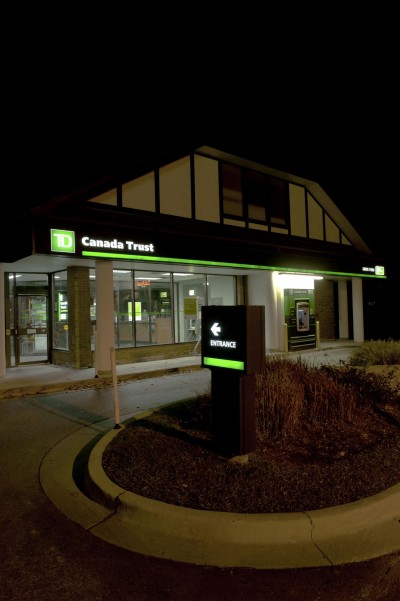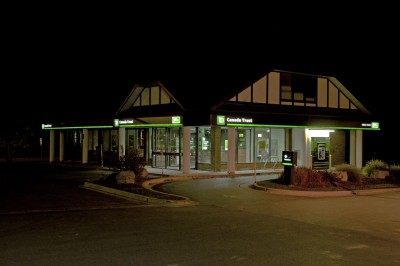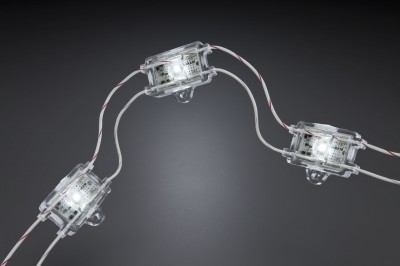Optimizing sign lighting systems
by Matthew | 25 January 2012 11:22 am
 [1]
[1]Photos courtesy Osram Sylvania
By Christopher Palmieri
While light-emitting diodes (LEDs) have become a popular technology for sign illumination, due to their efficiency, longevity and performance, they have not yet succeeded other types of light sources in all mainstream applications. Box signs, for example, are still waiting for LEDs to become the new standard.
LEDs are known for their inherent energy efficiency, but signmakers can also find further efficiency by optimizing the configuration of the lighting systems in their products. With more effective use of LEDs, they can reduce the quantity of modules needed for a given sign, while at the same time reducing labour costs.
Near the surface
One of the keys is to use LED modules with optical lenses, which provide up to 30 per cent better application efficiency than systems without lenses. By distributing a light beam across angles up to 155 degrees, an optical lens ensures uniformly even illumination and colour consistency, given standard lamp spacing at a shallow sign depth of 102 mm (4 in.).
Optical lenses thus help avoid ‘hot spots’ on a sign face, i.e. areas that appear brighter than other ‘dark spots.’ High-wattage LEDs placed too close to the sign face, on the other hand, will cause these spots through poor light distribution.
Indeed, with a shallow depth of installation, LEDs can shine evenly but also relatively brighter, without increasing wattage. A much higher lumen output and/or a greater number of LEDs and power supplies—and, thus, more hours of labour for installation—would be needed, for example, to achieve the same appearance if the modules were 152 to 305 mm (6 to 12 in.) away from the sign face. Generally, for every 51 mm (2 in.) further distance between the LEDs and the sign face, there is an approximately 25 per cent decrease in lighting effectiveness.
So, by installing the lighting modules closer to the surface, the sign can be populated less densely in terms of the overall number of LEDs. This reduces costs, because fewer LEDs will need to be purchased for a given project and less wattage will be needed on an ongoing basis.
 [2]
[2]These Toronto-Dominion (TD) Canada Trust branches in London, Ont., use LEDs to illuminate a variety of box signs.
When a box sign is pole-mounted, another advantage of installing the LEDs near the face is the prevention of a pole shadow showing through the sign. That said, many of the same benefits apply to channel letters (either internally illuminated or halo-lit), low-profile indoor signs, cove lighting and other applications where LEDs are replacing neon or fluorescent lighting. Signmakers can finally be rid of the ‘jail bar’ effects seen with fluorescent tubes mounted inside poster boxes.
When stringing ‘chains’ of LEDs throughout a sign, e.g. following the shapes of different channel letters, brighter modules with better light distribution will prove most efficient, requiring the least amount of installation work. Less expensive chains, on the other hand, will need to be purchased in greater quantities to achieve the same effect—and that means more time needed for installation. Again, the goal is to minimize the distance from the sign face and maximize the stroke spacing between modules.
Plug and play
Different jobs will entail different lighting requirements and pricing. Channel letters, especially, come in all imaginable sizes and depths, requiring a variety of versatile LED module types to illuminate them.
In some deep signs, for example, brighter LEDs are needed if they cannot be installed close enough to the face. Some of the appropriate modules offer a wider beam angle of up to 170 degrees to support even lighting in this type of configuration.
 [3]
[3]Low-profile, edge-lit LED panels allow illuminated signs to be placed nearly flush against wall surfaces.
Many ‘plug and play’ LEDs are very easy to install. They can be mounted along a profile track with predrilled holes, allowing them to be snapped right into place. The elongated track can be cut to the desired length—and given the predrilling, there is no need to measure the track, but instead simply count the right number of holes.
Another important advantage is protection against moisture. As durable solid-state products, LEDs are well-positioned to survive exposure to the elements.
Other forms
For the narrowest applications, edge-lit LED panels are available. At approximately 25 mm (1 in.) in depth, they are thinner than any fluorescent systems, allowing point-of-purchase (POP) displays, trade show graphics, menu boards and other signs to be installed in new places they could not before, nearly flush against wall surfaces. They are also more energy-efficient than fluorescent lighting and can last up to 2.5 times longer.
The low-profile panels can even be installed in jewellery cases and coolers in grocery stores, for example, where their lack of heat is advantageous over other forms of lighting. They use a ‘light guide’ to ensure uniform beam distribution across their dimensions, with no hot or dark spots.
 [4]
[4]When stringing ‘chains’ of high-brightness (HB) LED modules through a sign, the goal is to minimize the distance from the sign face and maximize the stroke spacing between the modules.
Many sizes Many sizes of LED panels are possible for different applications, snapping into corresponding front-load hatch frames. These single-faced versions are proving popular in many retail environments, but double-faced models have also been developed and should available soon.
Meanwhile, ‘border flex’ LED tubing is proving well-suited for many neon replacement applications, including weather-exposed architectural accents. These products are available in reels and can fit the curves and contours of stylized sign shapes, while providing vibrant colours—including red, blue, yellow, green, orange and white—to match the appearance of neon tubes.
Not all LEDs are created equal. A wide range of products are available to fit various pricing needs. In many cases, however, the best way for signmakers to save money is not to buy the least expensive systems, but instead to choose the right modules for the job and then use them in a thoughtful manner, using elements of sign design to optimize their performance.
Christopher Palmieri is LED lighting systems product marketing manager for Osram Sylvania. For more information, visit www.sylvania.com[5].
- [Image]: http://www.signmedia.ca/wp-content/uploads/2014/02/TDBank-London2.jpg
- [Image]: http://www.signmedia.ca/wp-content/uploads/2014/02/TDBank_London1.jpg
- [Image]: http://www.signmedia.ca/wp-content/uploads/2014/02/ThinPanel_LED_Signage_edited-1.jpg
- [Image]: http://www.signmedia.ca/wp-content/uploads/2014/02/HF2X3_Horiz.jpg
- www.sylvania.com: http://www.sylvania.com
Source URL: https://www.signmedia.ca/optimizing-sign-lighting-systems/